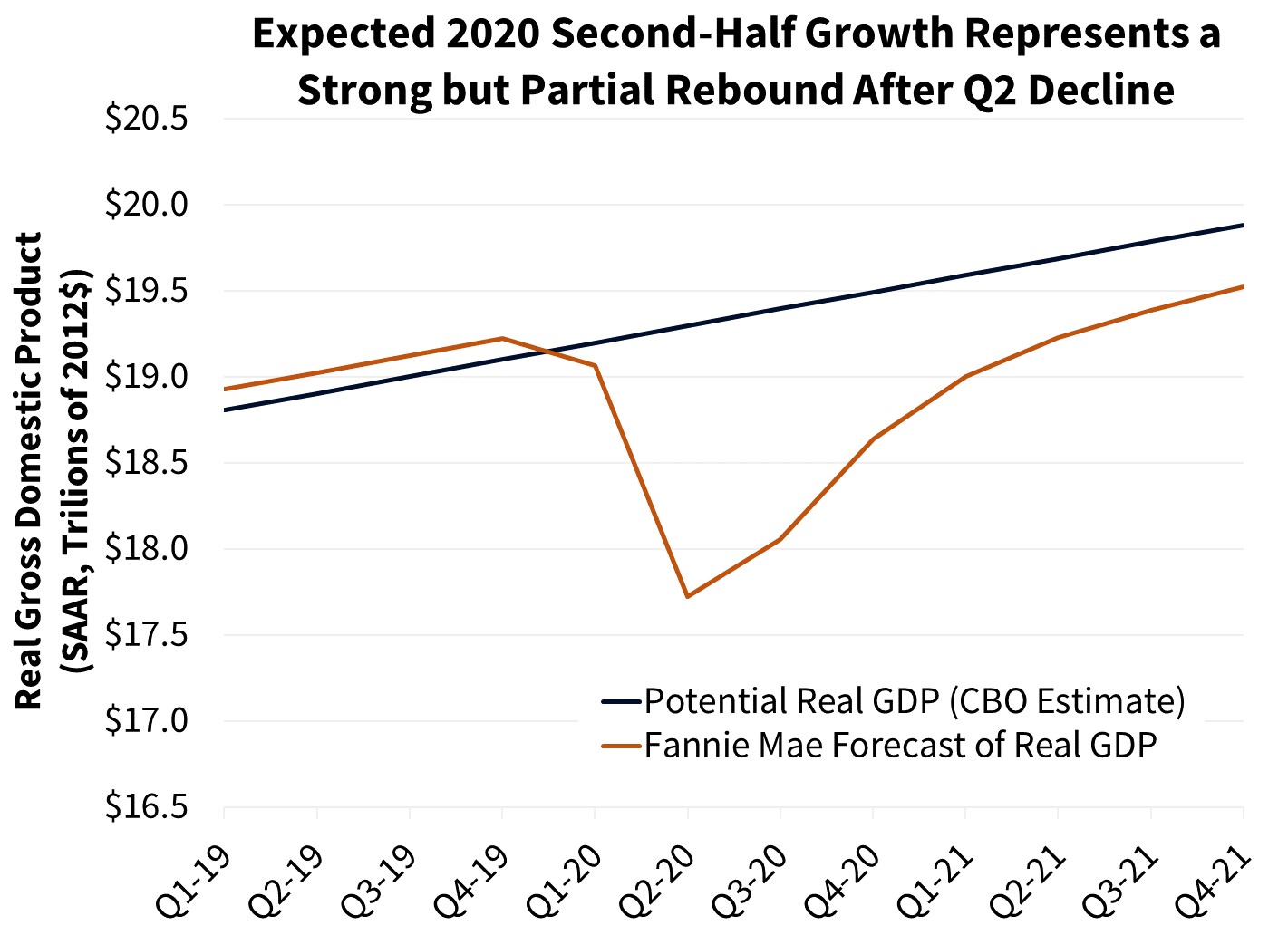Combined COVID-19 and Oil Shock Expected to End Longest Expansion
Uncertainty surrounding the nature, severity, and duration of the COVID-19 pandemic (coronavirus) has led to rapidly evolving estimates of its impact on economic growth. In our March forecast we reduced our outlook for 2020 GDP from 2.2 percent to 1.8 percent. Given recent events, we now expect GDP to contract by 3.1 percent in 2020. Due in part to the magnitude of fiscal and monetary policy responses to date, we expect 2021 GDP growth to be 4.8 percent.
With consumers staying home, businesses remaining shut, and household financial stress growing, the second quarter is likely to post a record decline in economic activity and employment. The duration of shutdown measures is still unknown and is likely to vary by geography and industry. The Director of the National Institute of Allergy and Infectious Diseases stated in mid-March that he expected shutdowns to likely last through the end of May. Therefore, in our forecast we have assumed that economic activity will begin to increase in June as social distancing measures and mandated shutdowns are eased. We expect this to be followed by above-average growth in the third and fourth quarter, partially making up for declines in the first half of 2020 (see our accompanying April economic forecast table for further details).
The downside scenario is one in which consumer spending and business investment recover at a slower pace. For example, the longer the shutdowns continue, the greater the risk that cash-constrained firms will close permanently, removing the conditions for a quick rebound. The National Federation of Independent Business reported in its March survey that 50 percent of small businesses could survive 2 months or less under current conditions. In this downside scenario, 2020 GDP could decline by nearly 10 percent, followed by only modest growth in 2021.
The upside scenario, which we believe is less likely, is a more rapid recovery from the first half downturn. In this scenario, while the first and second quarters would post declines similar to our baseline forecast, the coronavirus would abate or be mitigated more rapidly. Under such conditions, consumers would quickly emerge from social distancing, increasing consumption and allowing for a resurgence in growth supported by expansive monetary and fiscal policies, which would more fully make up for the first two quarters of declines. Output in 2020 would only fall by 1-2 percent, with a healthy rebound expected the following year.
Housing was in a strong position at the beginning of the year. We expect that residential fixed investment rose by the largest annualized amount since 2012 in the first quarter. However, heading into the second quarter, housing activity is expected to slow significantly. Between declining purchase mortgage applications, falling new single-family for-sale home listings, and waning consumer confidence, it is evident that people are holding off on purchasing and selling homes in light of the major uncertainties surrounding the effects of the virus and the outlook for the economy. Thus, we are expecting a sharp decline in total home sales and housing starts in the second quarter and all of 2020. A lower home-sale path relative to our March forecast led us to revise downward purchase mortgage originations this month by nearly $300 billion for 2020. However, the low mortgage rate environment should continue to support refinance volumes, which we revised upward from last month’s forecast by around $240 billion. Overall, 2020 originations should rise to $2.5 trillion with a refinance share of 56 percent.
Job Losses Likely to Reach Unprecedented Levels
Government-enforced business closures along with extensive social distancing measures have led to a meaningful decline in activity for many industries, including retail, dining, and travel. Additionally, the decline in demand, as well as a conflict between Saudi Arabia and Russia over production levels, have driven down oil prices dramatically, thereby putting US oil producers under significant pressure. Despite potential production cuts by OPEC, Russia and US producers, we expect oil prices to remain low throughout the year. Thus, headline inflation will likely see a significant year-over-year deceleration throughout 2020.
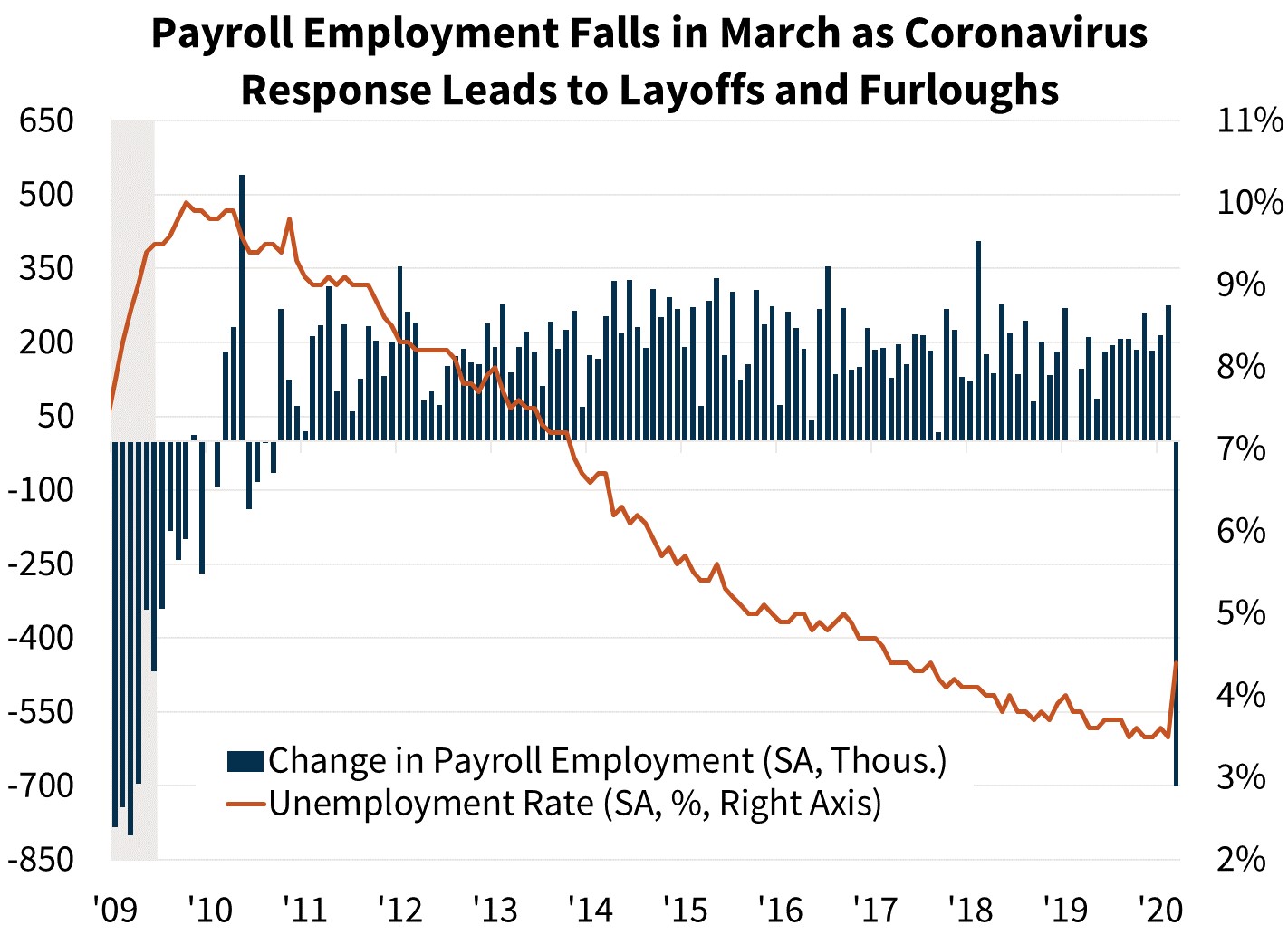
The March employment report reflected the first wave of job losses stemming from the coronavirus pandemic. Nonfarm payroll employment fell by 701,000 in March, the largest decline since March 2009. The unemployment rate jumped to 4.4 percent, the largest one-month increase in 45 years, illustrating the sudden nature of the current economic contraction. Service-providing industries made up the majority of job losses; for example, the leisure and hospitality sector posted a loss of 459,000 jobs. This was a reversal from the job gains seen in the first two months of the year, but larger losses are expected in the coming months.
We predict employment losses to reach record levels in the second quarter with the peak decline in April. According to the Department of Labor, in the three weeks ending April 4, initial unemployment insurance claims (not seasonally adjusted) had risen to about 15 million people, nearly 10 percent of the workforce. However, many of these workers may drop out of the labor force as the lack of job prospects and continued pressure to practice social distancing leads them to stop searching for new employment. This would result in them being classified as “discouraged workers” and removed from the count of individuals in the labor force. The potential for a decline in the labor force suggests the technical level of unemployment going forward may not fully encompass the full magnitude of lost jobs and hours worked. Our expectation is for the unemployment rate to average nearly 12 percent in the second quarter but end the year around 7 percent as the pandemic eases and shutdowns abate.
Beyond fear of infection, job losses are likely contributing to a recent downturn in consumer sentiment. According to the University of Michigan’s preliminary April survey data, consumer sentiment posted the largest one-month decline in the survey’s 42-year history, falling from near an expansion high to the lowest level since 2011. Despite the unprecedented response from the government attempting to alleviate the financial stress on households, it is likely sentiment will erode further, potentially reversing the cumulative confidence gains over the past 9 years in only a couple of months, particularly as the unemployment insurance claims suggest unemployment will show an increase in the May Labor Department report.
Monetary and Fiscal Policy Responses
In the first half of March, the Federal Reserve held two emergency meetings at which it cut the federal funds rate by a total of 150 basis points to a range of 0.00-0.25 percent. This was in response to the coronavirus outbreak, with the minutes from the March 15 meeting revealing that participants “viewed the near-term economic outlook as having deteriorated sharply…and as having become profoundly uncertain.” Participants also noted that housing market activity would be negatively affected by social distancing measures and by household financial stress. We removed our call for an increase in the federal funds rate in early 2021 and now believe the Fed will remain on hold throughout 2021, or until the economy can make a full recovery.
In addition to cutting interest rates effectively to the zero-lower bound, the Fed has also implemented other accommodative policies. The Fed began quantitative easing in mid-March, agreeing to buy at least $500 billion of Treasuries and $200 billion of agency mortgage-backed securities over the coming months. However, both MBS and investment grade debt spreads continued to widen, leading the Fed to ramp up balance sheet purchases, buying around $1.2 trillion in securities between March 11 and April 8. The Fed’s balance sheet now sits at over $6.0 trillion after starting the year at $4.1 trillion. Recently, the Fed also announced that it would provide up to $2.3 trillion in loans to assist households and employers, as well as state and local governments. These loan programs should improve the flow of credit and slow the deterioration of small business and household confidence.
The Fed’s actions were in tandem with fiscal policy in the form of a $2 trillion stimulus bill, the CARES Act, passed at the end of March. Some general details of the legislation include extending and increasing, as well as broadening, unemployment benefits, providing loans to various struggling industries, promising direct checks to individuals under certain income thresholds, funding hospital grants, and creating a tax credit for employers who keep idle workers on payroll. This level of monetary and fiscal policy response is intended to provide households and firms a lifeline over the coming weeks and months, while providing a strong tail wind for a recovery in economic activity during the second half of the year.
Home Sales and Housing Starts are Expected to Slow
Given the economic outlook, we are now forecasting a 36 percent annualized decline in residential fixed investment in the second quarter. This follows an upwardly revised forecast of 19 percent growth in the first quarter, reflecting strong activity predating the effects of the coronavirus pandemic.
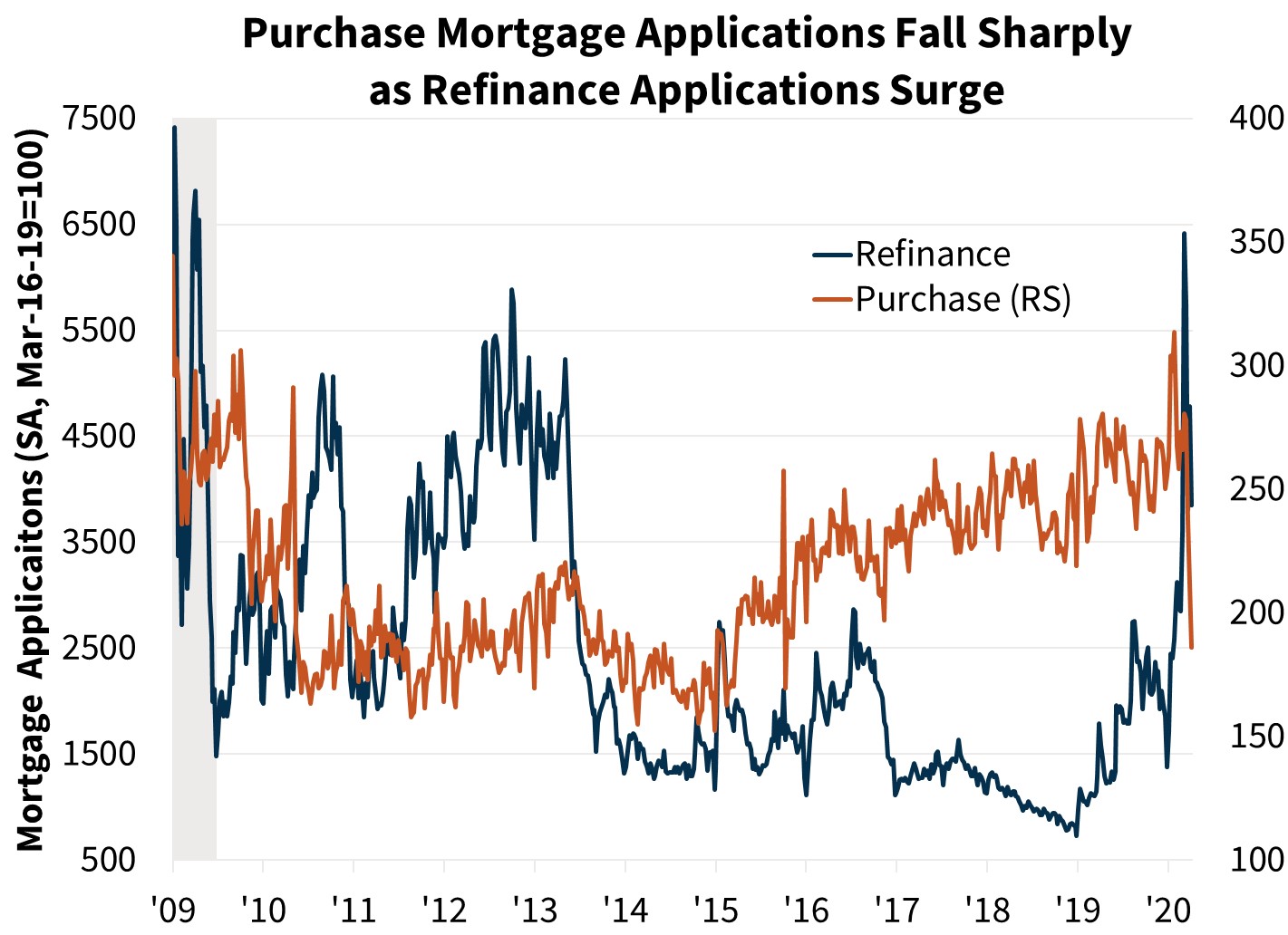
Strong home sales growth continued through February, prior to the outbreak, exceeding our previous expectations. Existing sales rose by 6.5 percent in February to the highest level since 2007, while February pending sales rose 2.4 percent, suggesting further growth in March even as economic activity was beginning to slow. With sales data only through February, predating many business shutdowns and social distancing measures, a high degree of uncertainty exists about the extent of the slowdown in sales. The Fannie Mae Home Purchase Sentiment Index® (HPSI) fell 11.7 points in March to 80.8, the largest single-month decline in the survey’s history, reflecting quickly diminishing homebuyer sentiment. According to the Mortgage Bankers Association, purchase mortgage applications fell by a cumulative 33 percent between March 13 and April 3, and we expect further declines. A recent survey by the National Association of Realtors’ conducted in the first week of April showed that 90 percent of its members reported declining buyer interest, with 45 percent of respondents reporting declines of more than 50 percent. Utilizing Google Trends data, our own analysis suggests that early April contract signings were down approximately 35-40 percent from a year ago.
Our forecast is that existing sales will fall 34 percent to an annualized rate of 3.76 million units in the second quarter, a sales pace similar to the lowest quarters of the Great Recession. It is likely that monthly sales will decline to an even lower annualized pace, in part as evidenced by the decline in the HPSI. However, April sales should at least be bolstered by contract signings from March or even February, giving modest support to the quarterly total. The subsequent offsetting dynamic will lead to a drag on third quarter home sales, even as economic activity is expected to begin gradually accelerating. Despite a projection for strong sales in the final quarter of the year, 2020 existing sales are forecast to fall 15 percent from 2019.
New home sales are likely to follow a similar path, though due to being recorded at the point of contract signing rather than closing, the data will likely show a steep decline in April and a quicker recovery over the summer months. We forecast new home sales to decline 40 percent in the second quarter, followed by a partial rebound of 34 percent in the third quarter. New sales, which had been accelerating prior to the recent slowdown, are now expected to fall 11.9 percent in 2020.
Our 2020 house price forecast was revised downward from 4.6 percent to 0.4 percent year over year. While the slowdown in housing activity will likely correspond with weaker home price appreciation, we do not believe house price declines will be sustained on a national basis in our baseline forecast. Besides the expected short-run nature of this economic downturn, we believe there are additional factors limiting price softness. First, entering the current downturn, a lack of housing supply was putting upward pressure on prices. The months’ supply of existing homes for sale was just 3.1, a record low for the month of February. Second, the nature of the current sales slowdown is two-sided. Demand is declining as economic confidence falls and people avoid home tours due to social distancing. However, there is also a negative supply response as well, due to potential sellers not wanting to list their homes out of worry of infection or due to their belief that there are few buyers in the market. Therefore, an excess supply of available listings is not likely even as sales slow sharply. Realtor.com reported that for the week ending April 5 new listings fell by 31 percent from the year prior. In the March HPSI, the net number of respondents indicating that it was a good time to sell fell by 15 percentage points, much larger than the 3-percentage-point decline in respondents who believe it is a good time to buy. This supports our view that the drop off in activity is partially supply driven and that sales should begin to move upward once infection worries ease.
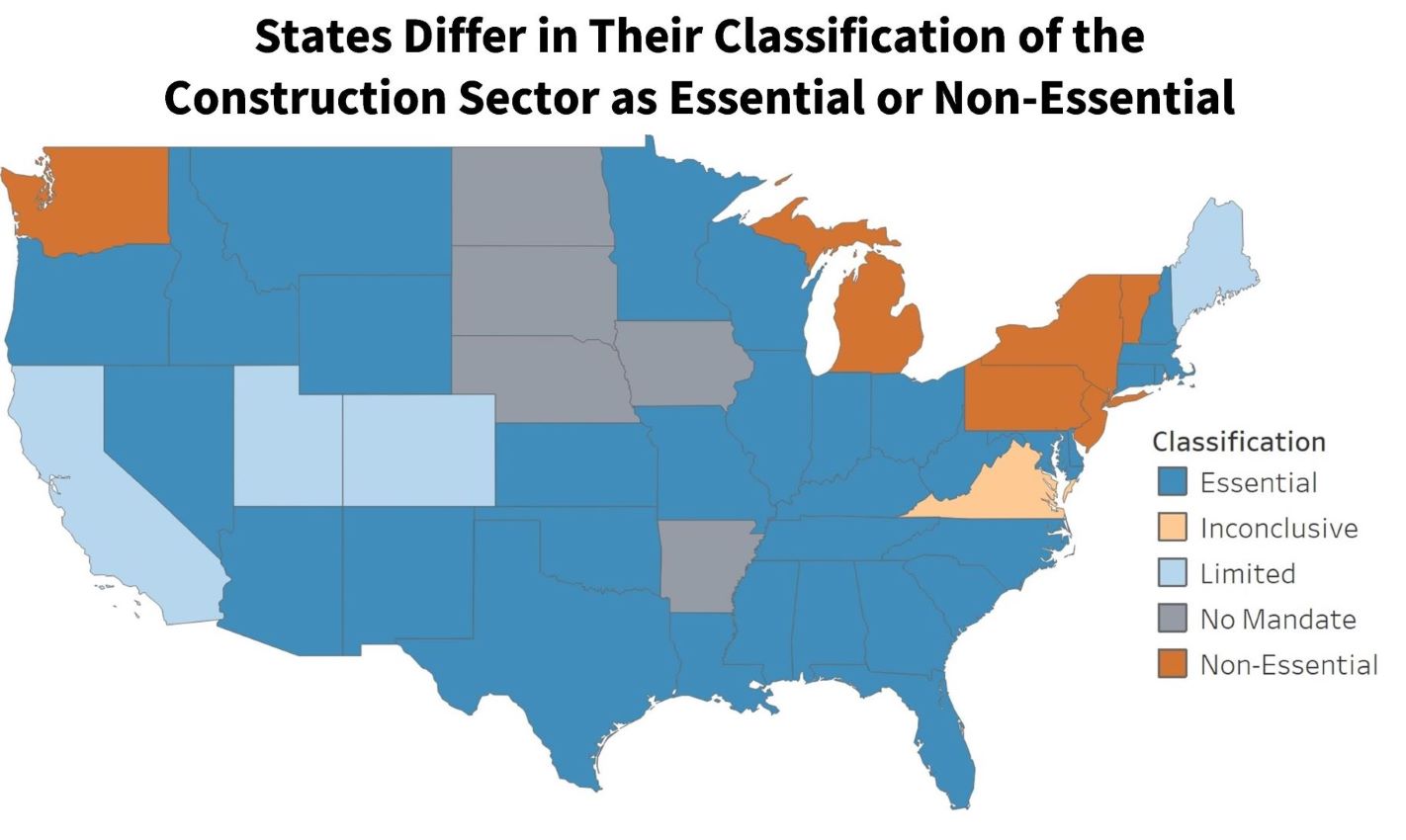
A handful of states have ordered a cessation of building activity, deeming construction a non-essential industry. These states are concentrated mostly in the Northeast where only a small share of single-family home building occurs. While the home construction industry is likely to fare better than many customer-facing services, it will likely still be disrupted. In a recent survey conducted by The National Association of Home Builders, 72 percent of respondents reported declines in buyer traffic to a “major extent,” 26 percent reported workers or contractors not willing to work on building sites, and 40 percent reported difficulty in obtaining needed inspections and permits. Given these challenges, we expect homebuilders to focus on current project pipelines and to slow the pace of new starts until conditions improve. Single-family starts are forecast to fall 30 percent over the second quarter, with a rebound beginning in the third quarter. For the year, we expect single-family starts to fall 7.6 percent.
Similarly, multifamily construction is likely to slow. In part due to a different geographic distribution of multifamily construction, as well as longer project timelines and more complex permitting procedures relative to single-family, we expect multifamily starts to decline more rapidly in the short run. Multifamily starts are expected to fall 48 percent this quarter with only a modest rebound next quarter. For the year, multifamily starts are expected to decline 13.2 percent.
For more on multifamily market conditions please see the April 2020 Multifamily Market Commentary.
Refinance Boom Underway, Lenders to Remain Capacity Constrained
The downward revisions to our home sales and house price forecasts led us to downgrade purchase mortgage originations by approximately $300 billion from last month. We now project 2020 purchase origination volumes to total $1.1 trillion, down 14 percent from 2019, before a modest recovery to $1.3 trillion in 2021 as housing activity improves.
In contrast, we revised upward our refinance originations forecast given our view that mortgage rates should remain low for the duration of our forecast horizon. We project 2020 refinance origination volumes to total $1.4 trillion, up $240 billion compared to our prior forecast. According to the Mortgage Bankers Association, refinance applications rose 67 percent in March, and we expect the pipeline of refinances to continue in coming months. In 2021, we forecast refinance originations to decline to $1.2 trillion, representing an upward revision from $832 billion from our prior forecast.
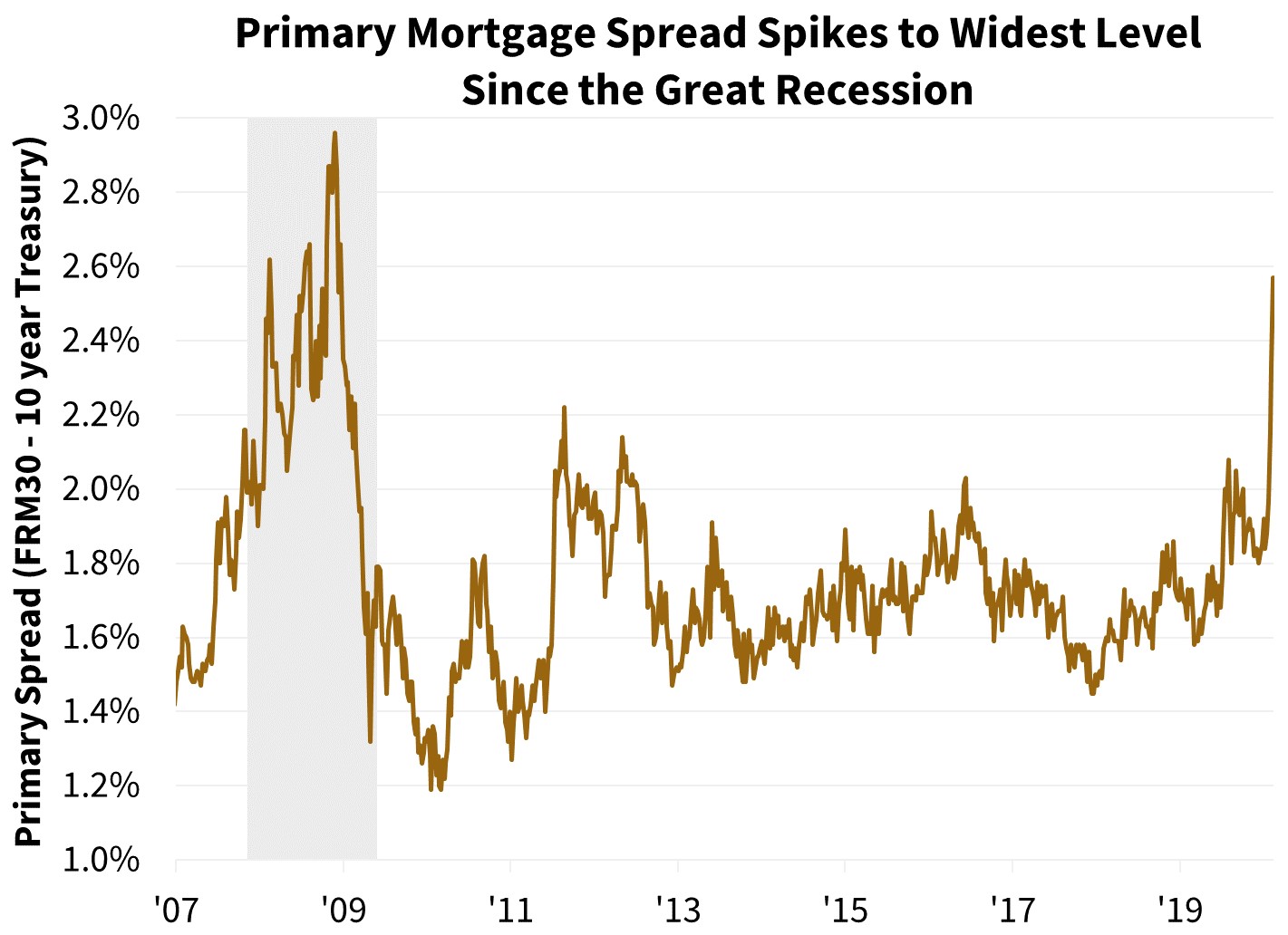
While the 30-year mortgage rate in March averaged a historic low of 3.45 percent, according to Freddie Mac, this was only 2 basis points below the February average despite sharp declines in Treasury rates. Spreads between the 10-year Treasury and the 30-year mortgage rate jumped to an average of 258 basis points over the month, the highest level since the depths of Great Recession. The mortgage spread during the first two months of the year had averaged around 190 basis points. While partially due to liquidity constraints in capital markets during the height of March’s financial market volatility, we credit the widened spread primarily to lender capacity constraints in the face of large refinance volumes.
With the average 30-year fixed mortgage rate at 3.3 percent as of this writing, we estimate that approximately 50 percent of all outstanding loan balances have at least a half-percentage point incentive to refinance. This share rises to around 70 percent if mortgage rates fall to 3.0 percent. This large pool of potential borrowers will likely sustain the strong mortgage demand driving capacity constraints, particularly in light of lenders having to accommodate social distancing and manage financial market volatility themselves. While we believe mortgage rates will drift downward as the spread narrows, capacity constraints will continue to influence how quickly mortgage rates drop and, therefore, refinance volumes. A mitigating factor to refinance demand could be the level of forbearance requests made by current borrowers over time, dampening expected activity. However, due to the unknown magnitude and effects of potential forbearance policies, our current forecast has not been explicitly adjusted to account for this.
Economic & Strategic Research (ESR) Group
April 15, 2020
For a snapshot of macroeconomic and housing data between the monthly forecasts, please read ESR's Economic and Housing Weekly Notes.
Data source for charts: Google Trends, Johns Hopkins CSSE, Mortgage Bankers Association, Bureau of Labor Statistics, Fannie Mae ESR Group.
Opinions, analyses, estimates, forecasts and other views of Fannie Mae's Economic & Strategic Research (ESR) Group included in these materials should not be construed as indicating Fannie Mae's business prospects or expected results, are based on a number of assumptions, and are subject to change without notice. How this information affects Fannie Mae will depend on many factors. Although the ESR group bases its opinions, analyses, estimates, forecasts and other views on information it considers reliable, it does not guarantee that the information provided in these materials is accurate, current or suitable for any particular purpose. Changes in the assumptions or the information underlying these views, including assumptions about the duration and magnitude of shutdowns and social distancing, could produce materially different results. The analyses, opinions, estimates, forecasts and other views published by the ESR group represent the views of that group as of the date indicated and do not necessarily represent the views of Fannie Mae or its management.
ESR Macroeconomic Forecast Team
- Doug Duncan, SVP and Chief Economist
- Eric Brescia, Economist
- Rebecca Meeker, Financial Economist
- Mark Palim, VP and Deputy Chief Economist
- Nick Embrey, Economist
- Richard Goyette, Business Analyst
